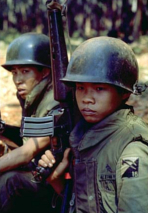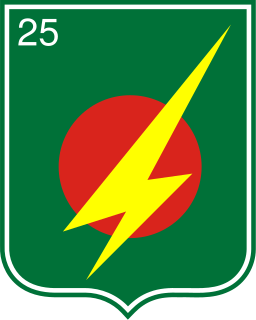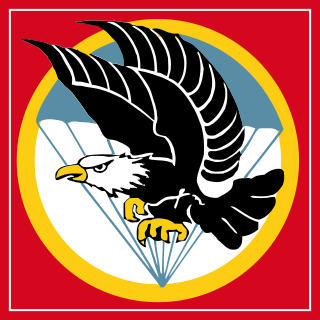
The Army of the Republic of Vietnam were the ground forces of the South Vietnamese military from its inception in 1955 to the Fall of Saigon in April 1975. It is estimated to have suffered 1,394,000 casualties during the Vietnam War.

The Fall of Saigon, also known as the Liberation of Saigon by North Vietnamese, was the capture of Saigon, the capital of South Vietnam, by the People's Army of Vietnam (PAVN) and the Viet Cong on 30 April 1975. The event marked the end of the Vietnam War and the start of a transition period to the formal reunification of Vietnam into the Socialist Republic of Vietnam.

The Battle of Xuân Lộc was the last major battle of the Vietnam War. From the beginning of 1975, People's Army of Vietnam (PAVN) forces swept through the northern provinces of South Vietnam virtually unopposed. In the Central Highlands, South Vietnam's II Corps was completely destroyed, whilst attempting to evacuate to the Mekong Delta region. In the cities of Huế and Da Nang, ARVN units simply dissolved without putting up resistance. The devastating defeats suffered by the Army of the Republic of Vietnam (ARVN) prompted South Vietnam's National Assembly to question President Nguyễn Văn Thiệu's handling of the war, thereby placing him under tremendous pressure to resign.

Tan Son Nhut Air Base (1955–1975) was a Republic of Vietnam Air Force (RVNAF) facility. It was located near the city of Saigon in southern Vietnam. The United States used it as a major base during the Vietnam War (1959–1975), stationing Army, Air Force, Navy, and Marine units there. Following the Fall of Saigon, it was taken over as a Vietnam People's Air Force (VPAF) facility and remains in use today.
The Battle of the Iron Triangle took place from 16 May to 20 November 1974, when the People's Army of Vietnam (PAVN) 9th Division captured Rach Bap and An Dien. The Army of the Republic of Vietnam (ARVN) regained the lost towns in a series of costly counterattacks.

Operation Lam Son 719 or 9th Route – Southern Laos Campaign was a limited-objective offensive campaign conducted in the southeastern portion of the Kingdom of Laos. The campaign was carried out by the armed forces of South Vietnam between 8 February and 25 March 1971, during the Vietnam War. The United States provided logistical, aerial and artillery support for the operation, but its ground forces were prohibited by law from entering Laotian territory. The objective of the campaign was the disruption of a possible future offensive by the People's Army of Vietnam (PAVN), whose logistical system within Laos was known as the Ho Chi Minh Trail.

The Battle of Ban Me Thuot was a decisive battle of the Vietnam War which led to the complete destruction of South Vietnam's II Corps Tactical Zone. The battle was part of a larger North Vietnamese military operation known as Campaign 275 to capture the Tay Nguyen region, known in the West as the Vietnamese Central Highlands.
The Battle of Svay Rieng was the last major offensive operation of the Vietnam War to be mounted by the South Vietnamese Army of the Republic of Vietnam (ARVN) against the North Vietnamese People's Army of Vietnam (PAVN) forces.

The Battle of Phước Long was a decisive battle of the Vietnam War which began on December 12, 1974, and concluded on January 6, 1975. The battle involved the deployment of the People's Army of Vietnam (PAVN) 4th Army Corps for the first time, against determined units of the Army of the Republic of Vietnam (ARVN) in Phước Long in Bình Phước Province near the Cambodian border, under the command of Lieutenant General Dư Quốc Đống.

The Battle of Lộc Ninh was a major battle fought during the Easter Offensive during the Vietnam War, which took place in Bình Long Province, South Vietnam between 4–7 April 1972. Towards the end of 1971, North Vietnamese leaders decided to launch a major offensive against South Vietnam, with the objective of destroying Army of the Republic of Vietnam (ARVN) units and capturing as much territory as possible, in order to strengthen their bargaining position in the Paris Peace Accords. On 30 March 1972, two People's Army of Vietnam (PAVN) divisions smashed through the Vietnamese Demilitarized Zone, marking the commencement of the Easter Offensive. They quickly overwhelmed South Vietnamese units in the I Corps Tactical Zone. With the rapid collapse of South Vietnamese forces in the northern provinces of South Vietnam, PAVN and Viet Cong (VC) forces began preparing for their next offensive, targeting Bình Long Province in the rubber plantation region north of Saigon. On 4 April, the VC 5th Division opened their attack on Lộc Ninh, defended by the ARVN 9th Infantry Regiment. After three days of fighting, the vastly outnumbered ARVN forces, though well supported by American air power, were forced to abandon their positions in Lộc Ninh.

The Republic of Vietnam Marine Division was part of the armed forces of South Vietnam. It was established by Ngo Dinh Diem in 1954 when he was Prime Minister of the State of Vietnam, which became the Republic of Vietnam in 1955. The longest-serving commander was Lieutenant General Le Nguyen Khang. In 1969, the VNMC had a strength of 9,300, 15,000 by 1973, and 20,000 by 1975.

The Vietnamese Rangers, properly known in Vietnamese as the Biệt Động Quân (En:Commando) and commonly known as the ARVN Rangers, were the light infantry of the Army of the Republic of Vietnam. Trained and assisted by American Special Forces and Ranger advisers, the Vietnamese Rangers infiltrated beyond enemy lines in search and destroy missions. Initially trained as a counter-insurgency light infantry force by removing the fourth company each of the existing infantry battalions, they later expanded into a swing force capable of conventional as well as counter-insurgency operations, and were relied on to retake captured regions. Later during Vietnamization the Civilian Irregular Defense Group program was transferred from MACV and integrated as Border Battalions responsible for manning remote outposts in the Central Highlands.

The 25th Division of the Army of the Republic of Vietnam (ARVN)—the army of the nation state of South Vietnam that existed from 1955 to 1975—was part of the III Corps that oversaw the region of the country surrounding the capital, Saigon. It was based at Củ Chi Base Camp to the northwest of the city.

The 2nd Division was a division of the Army of the Republic of Vietnam (ARVN)—the army of the nation state of South Vietnam that existed from 1955 to 1975. It was part of I Corps that oversaw the northernmost region of South Vietnam.

The Vietnamese Airborne Division was one of the earliest components of the Republic of Vietnam Military Forces. The Vietnamese Airborne Division began as companies organized in 1948, prior to any agreement over armed forces in Vietnam. After the partition of Vietnam, it became a part of the Army of the Republic of Vietnam. This division had its distinct origins in French-trained paratrooper battalions, with predecessor battalions participating in major battles including Dien Bien Phu and retained distinct uniforms and regalia. With the formation of an independent republic, the colonial paratroopers were dissolved, however regalia and aesthetics alongside the nickname "Bawouans" would be retained.

The Hue–Da Nang Campaign was a series of military actions conducted by the People's Army of Vietnam (PAVN) against the Army of the Republic of Vietnam (ARVN) during the Vietnam War, also known in Vietnam as the American War. The campaign was centred on the cities of Huế and Da Nang, with secondary fronts in the provinces of Quảng Trị and Quảng Ngãi. The campaign began on March 5 and concluded on April 2, 1975.

The attack on Tan Son Nhut Air Base, headquarters of the Republic of Vietnam Air Force (RVNAF) and the United States Air Force (USAF) 7th Air Force, occurred during the early hours of 31 January 1968. Tan Son Nhut Air Base was one of the major air bases used for offensive air operations within South Vietnam and for the support of United States Army and Army of the Republic of Vietnam (ARVN) ground operations. The attack by Vietcong (VC) and People's Army of Vietnam (PAVN) forces was one of several major attacks on Saigon in the first days of the Tet offensive. The attack was repulsed with the VC/PAVN suffering heavy losses; only superficial damage was done to the base.
The 10th Infantry Division is a division of the People's Army of Vietnam (PAVN), first formed in September 1972.

The Battle of West Saigon took place from 5–12 May 1968 during the May Offensive of the Vietnam War as South Vietnamese and United States forces countered the main thrust of the offensive against the western suburbs of Saigon.















